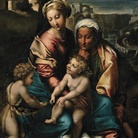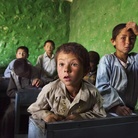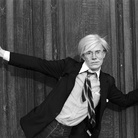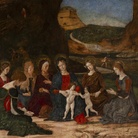El Banquete. El plan de los naufragos

El Banquete. El plan de los naufragos, La Fenice Gallery, Venezia
From 26 Luglio 2014 to 24 Agosto 2014
Venice
Place: La Fenice Gallery
Address: Corte del Tagiapiera S. Marco 1948
Times: Thursday to Sunday 2-6 pm or by appointment
Responsibles: Ana María Area Martínez
Telefono per informazioni: +39 041 5232333
E-Mail info: info@lafenicegallery.com
Official site: http://www.lafenicegallery.com
Starting from simple and familiar objects, the art collective ‘El Banquete’ composed by Alejandro Cinque, Raquel G. Ibáñez, Antonio Torres and Marta van Tartwijk, reflects about the dynamics of political power outlining the rhetorical methodologies whose purpose is to manifest itself in direct actions.
For their first exhibition in Italy, the space of La Fenice Gallery is redefined through a site specific installation that, by exploiting the use of a common object such as a glass bottle, it leads to a reflection on the clandestine media as a possibility of resistance to the excessive visibility and the constant control to which we are exposed every day.The visibility here is intended as a trap, as something binding, monitored and used like a support for surveillance from the authorities of the system. Likewise, the lack of visibility, the scattering, becomes an efficient manifestation of the clandestinity.
El plan de los náufragos aims to promote the empowerment of citizens through alternative channels of communication that are not controlled and allow the possibility of implementing an active resistance. The bottle becomes at the same time, a means to communicate a rebellious phrase from the French philosophical magazine Tiquun printed on a rag and a detonator of social and political protests. Connecting by one side to the figure of the castaway and his romantic and desperate gesture of throwing a bottle into the sea with a message inside; and on the other side to the political activist who throws bottles as a Molotov cocktail for undermining the system during urban guerrillas. In the first case, the act of resistance to the solitariness uses the drift and its floating fragility; in the second one, activism is set as an act of political resistance, in which the citizen designates its personal means of communication to launch a clandestine message of protest.
Proposing this action in a city like Venice inevitably raises certain issues that come back to reopen the tension between utopia and dystopia.
In the desert island the figure of the castaway, like a prisoner inside an imaginary utopia, reflects itself in the inhabitant of the city where the extreme gentrification and tourism makes that in the end the reality does not match the image from the postcard.
The project proposes a call to action, starting from an ideal of force of resistance that seeks to awaken the political entity inherent in the citizen to make him aware of his presence and his power.
For their first exhibition in Italy, the space of La Fenice Gallery is redefined through a site specific installation that, by exploiting the use of a common object such as a glass bottle, it leads to a reflection on the clandestine media as a possibility of resistance to the excessive visibility and the constant control to which we are exposed every day.The visibility here is intended as a trap, as something binding, monitored and used like a support for surveillance from the authorities of the system. Likewise, the lack of visibility, the scattering, becomes an efficient manifestation of the clandestinity.
El plan de los náufragos aims to promote the empowerment of citizens through alternative channels of communication that are not controlled and allow the possibility of implementing an active resistance. The bottle becomes at the same time, a means to communicate a rebellious phrase from the French philosophical magazine Tiquun printed on a rag and a detonator of social and political protests. Connecting by one side to the figure of the castaway and his romantic and desperate gesture of throwing a bottle into the sea with a message inside; and on the other side to the political activist who throws bottles as a Molotov cocktail for undermining the system during urban guerrillas. In the first case, the act of resistance to the solitariness uses the drift and its floating fragility; in the second one, activism is set as an act of political resistance, in which the citizen designates its personal means of communication to launch a clandestine message of protest.
Proposing this action in a city like Venice inevitably raises certain issues that come back to reopen the tension between utopia and dystopia.
In the desert island the figure of the castaway, like a prisoner inside an imaginary utopia, reflects itself in the inhabitant of the city where the extreme gentrification and tourism makes that in the end the reality does not match the image from the postcard.
The project proposes a call to action, starting from an ideal of force of resistance that seeks to awaken the political entity inherent in the citizen to make him aware of his presence and his power.
SCARICA IL COMUNICATO IN PDF
el banquete alejandro cinque ·
raquel g ib ez ·
antonio torres ·
marta van tartwijk ·
el banquete alejandro cinque raquel g ib ez antonio torres marta van tartwijk
COMMENTI

-
 Dal 31 gennaio 2024 al 04 maggio 2025
Fermo | Palazzo dei Priori
Dal 31 gennaio 2024 al 04 maggio 2025
Fermo | Palazzo dei Priori
-
 Dal 20 dicembre 2024 al 04 maggio 2025
Fermo | Palazzo dei Priori
Dal 20 dicembre 2024 al 04 maggio 2025
Fermo | Palazzo dei Priori
-
 Dal 20 dicembre 2024 al 04 maggio 2024
Gorizia | Palazzo Attems Petzenstein
Dal 20 dicembre 2024 al 04 maggio 2024
Gorizia | Palazzo Attems Petzenstein
-
 Dal 18 dicembre 2024 al 18 dicembre 2024
Venezia | Museo Correr
Dal 18 dicembre 2024 al 18 dicembre 2024
Venezia | Museo Correr
-
 Dal 14 dicembre 2024 al 02 marzo 2025
Palermo | Palazzo Abatellis
Dal 14 dicembre 2024 al 02 marzo 2025
Palermo | Palazzo Abatellis
-
 Dal 12 dicembre 2024 al 23 febbraio 2025
Roma | Palazzo Altemps
Dal 12 dicembre 2024 al 23 febbraio 2025
Roma | Palazzo Altemps


